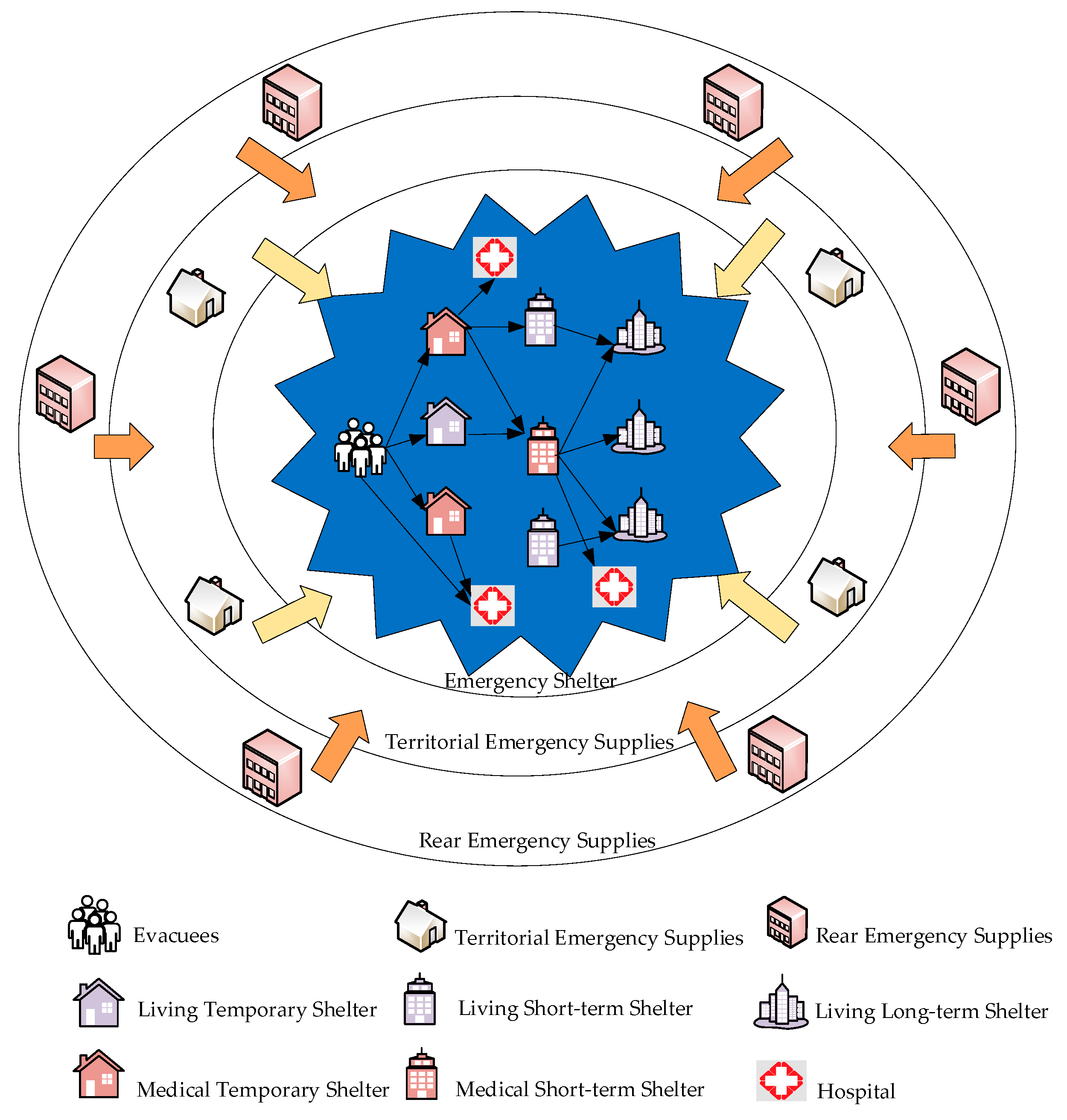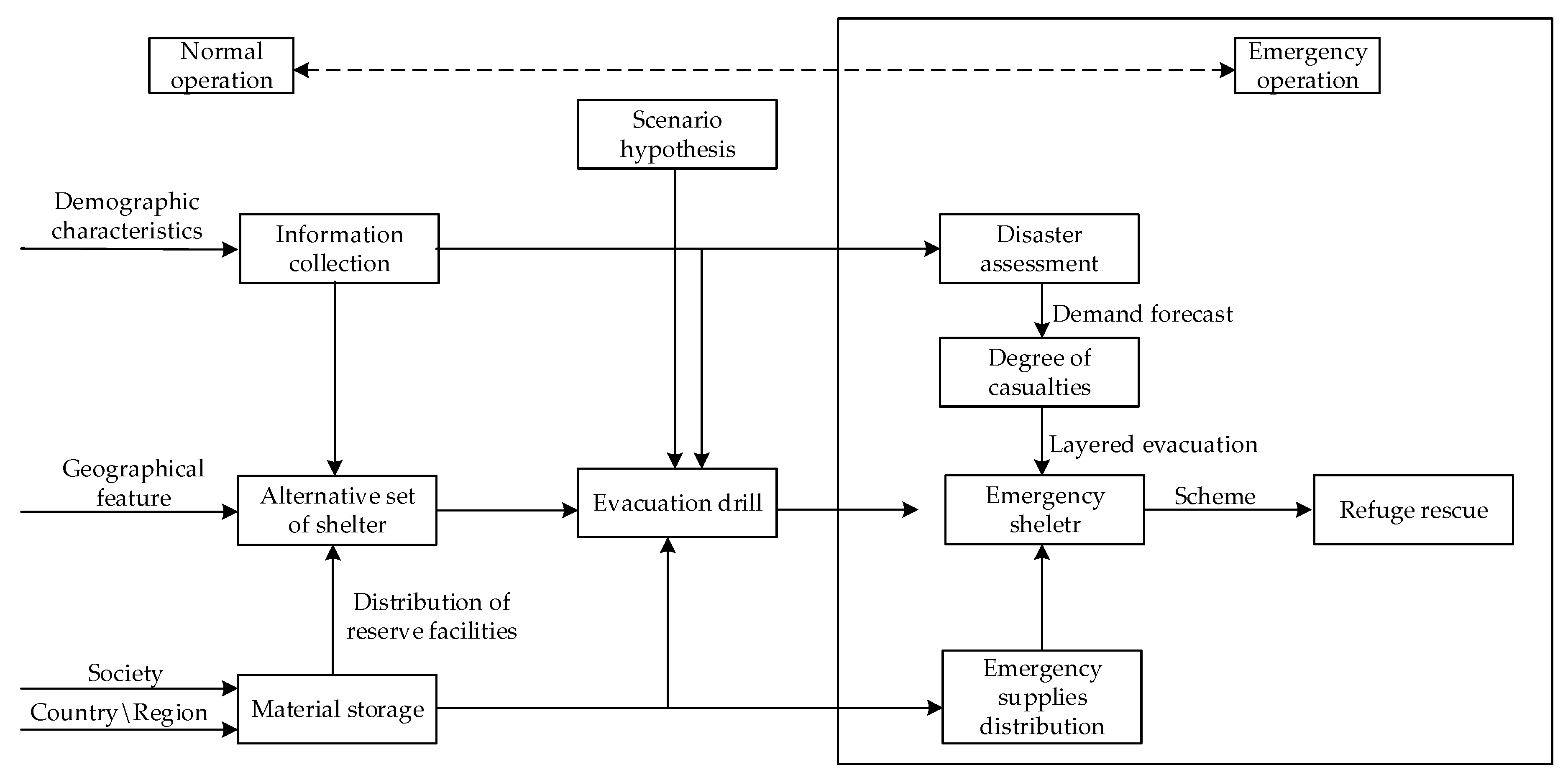The Mechanism of Operation Effectiveness of Emergency Shelter Rescue Systems
Abstract
1. Introduction
2. Connotations of the Emergency Shelter Rescue System
2.1. The Demand for Emergency Shelter
2.2. Emergency Shelters
- (1)
- Combination of peace and emergency
- (2)
- Dynamic balance
- (3)
- Utility
2.3. Emergency Supplies Distribution
3. The Structure of the Emergency Shelter Rescue System
3.1. Main Factors Affecting the Structure of Emergency Shelters Rescue
3.1.1. Complex Demand
3.1.2. Blind Refuge
3.1.3. Material Shortage
3.2. An Analytical Framework for the Effectiveness of Emergency Shelters Rescue
3.2.1. Demand Stratification
3.2.2. Diversion Refuge
3.2.3. Comprehensive Distribution
4. Analysis of the Rescue Operation of the Refuge
4.1. Operation Scene of Refuge Rescue
- (1)
- Evacuation of victims considering the stratification of demand
- (2)
- Rapid and accurate distribution of emergency supplies
- (3)
- Rescue Service Integration in Shelters
4.2. Action Mode of Refuge Rescue
- (1)
- Demand points
- (2)
- DClassification of shelters based on horizontal needs
- (i)
- Living emergency shelter
- (ii)
- Medical emergency shelter
- (3)
- Classification of shelters based on vertical needs
- (i)
- Temporary emergency shelter
- (ii)
- Short-term emergency shelter
- (iii)
- Long-term emergency shelter
- (4)
- Emergency material supply point
- (i)
- Territorial emergency material supply point
- (ii)
- Rear emergency material supply point
4.3. Operation Strategy of the Emergency Shelter Rescue System
4.3.1. Normal Operation
4.3.2. Emergency Operation
- (1)
- Disaster assessment
- (2)
- Casualty prediction
- (3)
- Shelter planning
- (4)
- Distribution plan
- (i)
- Temporary stage of the model
- (ii)
- Short-term stage of the model
- (iii)
- Long-term stage of the model
5. Conclusions
Author Contributions
Funding
Acknowledgments
Conflicts of Interest
References
- Trivedi, A.; Singh, A. Prioritizing emergency shelter areas using hybrid multi criteria decision approach: A case study. J. Multi-Criteria Decis. Anal. 2017, 24, 1–13. [Google Scholar] [CrossRef]
- Shi, W.; Wang, M. Three-dimensional observations from MODIS and CALIPSO for ocean responses to cyclone Nargis in the Gulf of Martaban. Geophys. Res. Lett. 2008, 35, L21603. [Google Scholar] [CrossRef]
- Bilham, R. Lessons from the Haiti earthquake. Nature 2010, 463, 878–879. [Google Scholar] [CrossRef] [PubMed]
- Nakashima, T.; Okada, S. Financial imbalances in regional disaster recovery following earthquakes—Case study concerning housing-cost expenditures in Japan. Sustainability 2018, 10, 3225. [Google Scholar] [CrossRef]
- Li, A.; Nozick, L.; Xu, N.; Davidson, R. Shelter location and transportation planning under hurricane conditions. Transp. Res. Part E Logist. Transp. Rev. 2012, 48, 715–729. [Google Scholar] [CrossRef]
- Pérez-Galarce, F.; Ca Nales, L.J.; Vergara, C.; Candia-Véjar, A. An optimization model for the location of disaster refuges. Socio-Econ. Plan. Sci. 2016, 59, 56–66. [Google Scholar] [CrossRef]
- Zhao, X.; Chen, J.; Xu, W.; Lou, S.; Du, P.; Yuan, H.; Ip, K.P. A three-stage hierarchical model for an earthquake shelter location-allocation problem: Case study of chaoyang dstrict, Beijing, China. Sustainability 2019, 11, 4561. [Google Scholar] [CrossRef]
- Kirac, E.; Milburn, A.B. A general framework for assessing the value of social data for disaster response logistics planning. Eur. J. Oper. Res. 2018, 269, 486–500. [Google Scholar] [CrossRef]
- Tang, X.; Ji, Z.; Peng, X. A multi-objective optimization model for sustainable logistics facility location. Transp. Res. Part D Transp. Environ. 2013, 22, 45–48. [Google Scholar] [CrossRef]
- Zhao, Y.; Zhou, Y.; Deng, W. Innovation mode and optimization strategy of B2C E-commerce logistics distribution under Big Data. Sustainability 2020, 12, 3381. [Google Scholar] [CrossRef]
- Zheng, F.; Liu, X.; Zuylen, H.V. A methodological framework of travel time distribution estimation for urban signalized arterial roads. Transp. Sci. 2017, 59, 115–117. [Google Scholar] [CrossRef]
- Yang, M.; Liu, Y.; Yang, G. Multi-period dynamic distributionally robust pre-positioning of emergency supplies under demand uncertainty. Appl. Math. Model 2020, 89, 1433–1458. [Google Scholar] [CrossRef]
- Website: UNDRR hazard report digital 2020. Available online: https://www.researchgate.net/publication/349105099_UNDRR_Hazard_Report_DIGITAL_2020 (accessed on 12 December 2020).
- Jena, S.D.; Cordeau, J.F.; Gendron, B. Modeling and solving a logging camp location problem. Ann. Oper. Res. 2012, 232, 1–27. [Google Scholar] [CrossRef]
- Fischetti, M.; Ljubić, I.; Sinnl, M. Benders decomposition without separability: A computational study for capacitated facility location problems. Eur. J. Oper. Res. 2016, 253, 557–569. [Google Scholar] [CrossRef]
- Vermuyten, H.; Beliën, J.; De Boeck, L.; Reniers, G.; Wauters, T. A review of optimisation models for pedestrian evacuation and design problems. Saf. Sci. 2016, 87, 167–178. [Google Scholar] [CrossRef]
- An, S.; Cui, N.; Li, X.; Ouyang, Y. Location planning for transit-based evacuation under the risk of service disruptions. Transp. Res. Part B Methodol. 2013, 54, 1–16. [Google Scholar] [CrossRef]
- Gupta, S.; Starr, M.K.; Farahani, R.Z.; Matinrad, N. Disaster management from a POM perspective: Mapping a new domain. Prod. Oper. Manag. 2016, 25, 1611–1637. [Google Scholar] [CrossRef]
- Chen, A.Y.; Yu, T.Y. Network based temporary facility location for the Emergency Medical Services considering the disaster induced demand and the transportation infrastructure in disaster response. Transp. Res. Part B Methodol. 2016, 91, 408–423. [Google Scholar] [CrossRef]
- Boonmee, C.; Arimura, M.; Asada, T. Facility location optimization model for emergency humanitarian logistics. Int. J. Disaster Risk Reduct. 2017, 24, 485–498. [Google Scholar] [CrossRef]
- Liu, C.; Mao, Z.L.; Fu, Z.M. Emergency evacuation model and algorithm in the building with several exits. Syst. Eng. Theory Pract. 2016, 31, 147–153. [Google Scholar] [CrossRef]
- Thomas, A.S.; Kopczak, L.R. From logistics to supply chain management: The path forward in the humanitarian sector. Fritz Inst. 2005, 15, 1–15. [Google Scholar]
- Sheu, J.B.; Cheng, P. A method for designing centralized emergency supply network to respond to large-scale natural disasters. Transp. Res. Part B Methodol. 2014, 67, 284–305. [Google Scholar] [CrossRef]
- Noyan, N.; Balcik, B.; Atakan, S. A stochastic optimization model for designing last mile relief networks. Transp. Sci. 2016, 50, 1092–1113. [Google Scholar] [CrossRef]
- Lindell, M.K.; Prater, C.S.; W, P.R. Introduction to Emergency Management; John Wiley & Sons: Hoboken, NJ, USA, 2007. [Google Scholar]
- Sabbaghtorkan, M.; Batta, R.; He, Q. Prepositioning of assets and supplies in disaster operations management: Review and research gap identification. Eur. J. Oper. Res. 2020, 284, 1–19. [Google Scholar] [CrossRef]
- Galindo, G.; Batta, R. Review of recent developments in OR/MS research in disaster operations management. Eur. J. Oper. Res. 2013, 230, 201–211. [Google Scholar] [CrossRef]
- Shaoqing, G.; Hanping, H.; Zhang, S. Multi-criteria location model of emergency shelter in humanitarian logistics. Sustainability 2017, 12, 1759. [Google Scholar] [CrossRef]
- Kılcı, F.; Kara, B.Y.; Bozkaya, B. Locating temporary shelter areas after an earthquake: A case for Turkey. Eur. J. Oper. Res. 2015, 243, 323–332. [Google Scholar] [CrossRef]
- Qian, H. Advances and prospects of cty emergency shelter’s operation in disaster. J. Catastrophol. 2017, 32, 160–165. [Google Scholar] [CrossRef]
- Afshar, A.; Haghani, A. Modeling integrated supply chain logistics in real-time large-scale disaster relief operations. Socio-Econ. Plan. Sci. 2012, 46, 327–338. [Google Scholar] [CrossRef]
- Chen, Z.; Chen, X.; Li, Q.; Chen, J. The temporal hierarchy of shelters: A hierarchical location model for earthquake-shelter planning. Int. J. Geogr. Inf. Sci. 2013, 27, 1612–1630. [Google Scholar] [CrossRef]
- Su, Y. Planning and Design of Urban Disaster Prevention and Refuge Sites; China Construction Industry Press: Beijing, China, 2012. [Google Scholar]
- Kepekci, D.; Ozcep, F. Brief communication “Fast-track earthquake risk assessment for selected urban areas in Turkey”. Nat. Hazards Earth Syst. Sci. 2011, 11, 571–585. [Google Scholar] [CrossRef]
- Wang, X.; Zhang, W.; Yu, Y.; Liu, B. An optimization model for emergency shelter location and relief materials allocation considering human suffering. Chin. J. Manag. Sci. 2019, 28, 1–12. [Google Scholar] [CrossRef]
- Sato, M.; Chen, S.W.; Satake, M. Polarimetric SAR analysis of tsunami damage following the March 11, 2011 East Japan Earthquake. Proc. IEEE 2012, 100, 2861–2875. [Google Scholar] [CrossRef]
- Farahani, R.Z.; Lotfi, M.; Baghaian, A.; Ruiz, R.; Rezapour, S. Mass casualty management in disaster scene: A systematic review of OR&MS research in humanitarian operations. Eur. J. Oper. Res. 2020, 287, 787–819. [Google Scholar] [CrossRef]
- Anaya-Arenas, A.M.; Renaud, J.; Ruiz, A. Relief distribution networks: A systematic review. Ann. Oper. Res. 2014, 223, 53–79. [Google Scholar] [CrossRef]
- Trivedi, A.; Singh, A. A hybrid multi-objective decision model for emergency shelter location-relocation projects using fuzzy analytic hierarchy process and goal programming approach. Int. J. Proj. Manag. 2017, 35, 827–840. [Google Scholar] [CrossRef]
- GB/T33744-2017. Emergency Shelter for Earthquake Disasters-Guidelines on the Operation and Management; China National Standardizing Committee: Beijing, China, 2017. [Google Scholar]
- Chang, H.S.; Liao, C.H. Planning emergency shelter locations based on evacuation behavior. Nat. Hazards 2015, 76, 1551–1571. [Google Scholar] [CrossRef]
- Gu, J.; Zhou, Y.; Das, A.; Moon, I.; Lee, G.M. Medical relief shelter location problem with patient severity under a limited relief budget. Comput. Ind. Eng. 2018, 125, 720–728. [Google Scholar] [CrossRef]
- Amideo, A.E.; Scaparra, M.P.; Kotiadis, K. Optimising shelter location and evacuation routing operations: The critical issues. Eur. J. Oper. Res. 2018, 279, 279–295. [Google Scholar] [CrossRef]
- GB 21734-2008. Emergency Shelter for Earthquake Disasters-Site And Its Facilities; China National Standardizing Committee: Beijing, China, 2008. [Google Scholar]
- Charles, A.; Lauras, M.; Van Wassenhove, L.N.; Dupont, L. Designing an efficient humanitarian supply network. J. Oper. Manag. 2016, 47–48, 58–70. [Google Scholar] [CrossRef]
- Li, H. Research on Urban Emergency Shelter Planning Models with Consideration of Varying Shelter Demand. Ph.D. Thesis, Shanghai University, Shanghai, China, 2018. [Google Scholar]
- Xu, J.; Yin, X.; Chen, D.; An, J.; Nie, G. Multi-criteria location model of earthquake evacuation shelters to aid in urban planning. Int. J. Disaster Risk Reduct. 2016, 20, 51–62. [Google Scholar] [CrossRef]
- Amin Hosseini, S.M.; Albert, D.; Pons, O. Multicriteria decision-making method for sustainable site location of post-disaster temporary housing in urban areas. J. Constr. Eng. Manag. 2016, 142, 04016036. [Google Scholar] [CrossRef]
- Knay, Ö.B.; Saldanha-Da-Gama, F.; Kara, B.Y. On multi-criteria chance-constrained capacitated single-source discrete facility location problems. Omega-Int. J. Manag. Sci. 2019, 83, 107–122. [Google Scholar] [CrossRef]
- Yahyaei, M.; Bozorgi-Amiri, A. Robust reliable humanitarian relief network design: An integration of shelter and supply facility location. Ann. Oper. Res. 2018, 283, 897–916. [Google Scholar] [CrossRef]





| Factor | Reference |
|---|---|
| Topography | Kılcı et al. [29], Trivedi and Singh [39], Xu et al. [47], Amin Hosseini et al. [48] |
| Geological type | Kılcı et al. [29], Trivedi and Singh [39], Amin Hosseini et al. [48] |
| Slope | Kılcı et al. [29], Trivedi and Singh [39], Knay et al. [49] |
| Vegetation | Li et al. [5], Yahyaei and Bozorgi-Amiri [50], GB/T33744-2017 [40] |
| Power facilities | Li et al. [5], Knay et al. [49], GB/T33744-2017 [40], Gu et al. [42] |
Publisher’s Note: MDPI stays neutral with regard to jurisdictional claims in published maps and institutional affiliations. |
© 2021 by the authors. Licensee MDPI, Basel, Switzerland. This article is an open access article distributed under the terms and conditions of the Creative Commons Attribution (CC BY) license (https://creativecommons.org/licenses/by/4.0/).
Share and Cite
Geng, S.; Hou, H.; Geng, J. The Mechanism of Operation Effectiveness of Emergency Shelter Rescue Systems. Sustainability 2021, 13, 5540. https://doi.org/10.3390/su13105540
Geng S, Hou H, Geng J. The Mechanism of Operation Effectiveness of Emergency Shelter Rescue Systems. Sustainability. 2021; 13(10):5540. https://doi.org/10.3390/su13105540
Chicago/Turabian StyleGeng, Shaoqing, Hanping Hou, and Jiaxin Geng. 2021. "The Mechanism of Operation Effectiveness of Emergency Shelter Rescue Systems" Sustainability 13, no. 10: 5540. https://doi.org/10.3390/su13105540
APA StyleGeng, S., Hou, H., & Geng, J. (2021). The Mechanism of Operation Effectiveness of Emergency Shelter Rescue Systems. Sustainability, 13(10), 5540. https://doi.org/10.3390/su13105540







